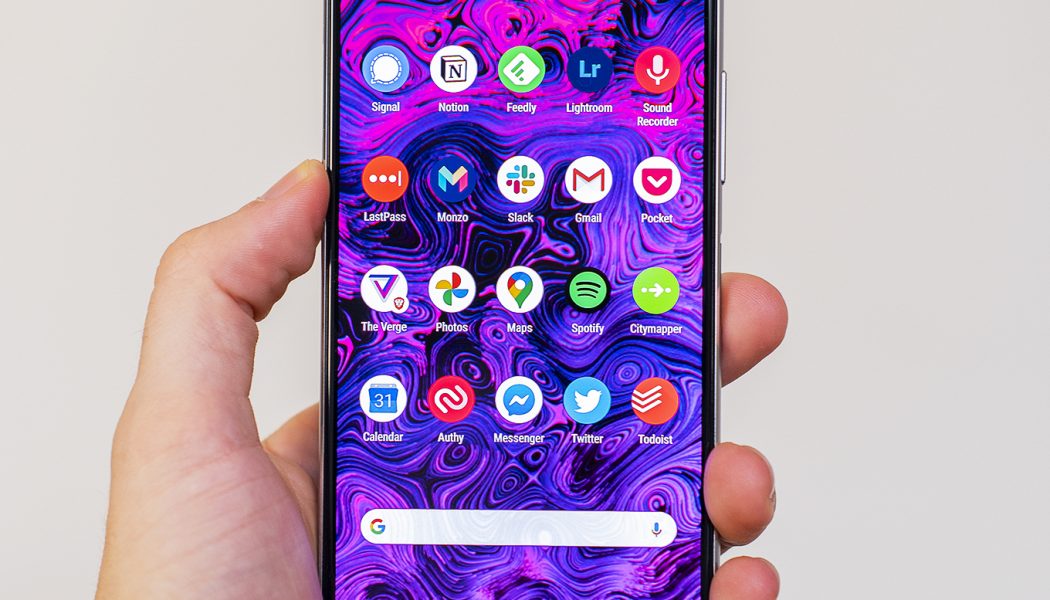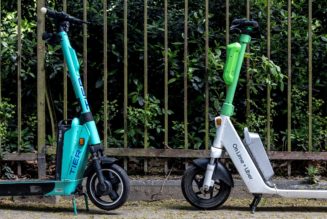It’s not often I receive a phone I immediately want to show off to everyone around me, but the Asus Zenfone 7 Pro is exactly that. The second I got the device set up, I ran into each of my flatmates’ rooms in turn and happily flipped and un-flipped its three rear cameras, swinging them around the top edge of the phone to turn them into selfie cameras.
It’s far from a unique trick (you can find a similar flipping array on last year’s Zenfone 6, among other handsets), but it’s still hardly mainstream. That means the Zenfone 7 Pro is almost guaranteed to get a reaction, whether it’s from friends when you try to take a selfie together or from strangers when you go to make a video call in public. There’s a lot to like about the Zenfone 7 Pro, but you’ve got to get behind the idea of cameras that flip if you’re considering a purchase.
The Asus Zenfone 7 Pro is launching in Europe today with prices starting at €799 (about $955). Alongside it, there’s also the Zenfone 7, which comes with a slightly slower processor and some camera compromises and starts at €699 (about $836). In Europe, both phones are coming to most major markets including Portugal, Spain, France, Germany, Italy, and Ireland, but not the UK. There are also no plans for an official release in North America.
The Zenfone 7 Pro’s cameras may be the most eye-catching thing about the device, but they’re attached to a capable phone. The Zenfone 7 Pro is powered by a flagship Qualcomm Snapdragon 865 Plus processor, paired with 8GB of RAM and 256GB of storage. In the standard Zenfone 7, meanwhile, you get a slightly slower Snapdragon 865 processor, 128GB of storage, and a choice of either 6GB or 8GB of RAM. Both support Sub-6GHz 5G, with no support for mmWave. In other words, they have a fairly typical set of flagship specs for 2020 and are what you should expect in a phone of this price.
The most noteworthy of the Zenfone 7 Pro’s specs, however, is its gargantuan 5,000mAh battery. Unsurprisingly, this translates into excellent battery life, and I’ve been consistently getting over six hours of screen-on time per charge. Over this past weekend, I used the phone as a cycling GPS using Google Maps for two hours (with some added music streaming over Bluetooth for good measure). Even though I didn’t charge the phone overnight, it still happily lasted until 6PM the following day.
When your battery runs dry, you can fast charge it at up to 30W, but as with the Zenfone 6, there’s no support for wireless charging.
:no_upscale()/cdn.vox-cdn.com/uploads/chorus_asset/file/21823080/jporter_200827_4166_0008.0.jpg)
:no_upscale()/cdn.vox-cdn.com/uploads/chorus_asset/file/21823083/jporter_200827_4166_0005.0.jpg)
Unfortunately, putting such a massive battery inside this phone hasn’t done any favors for its size or weight. The Zenfone 7 Pro is surprisingly heavy at 230 grams, which makes it heavier than both the iPhone 11 Pro Max and the Samsung Galaxy S20 Ultra 5G. There’s no escaping the fact that this is a big, bulky phone.
Considering its size, I was thankful to see almost its entire front covered by a big, bright, colorful 6.67-inch OLED display with a smooth 90Hz refresh rate. It’s only 1080p, which on a screen this big means it doesn’t have the pin-sharp detail of some other big phones, but given the choice between a high resolution and a high refresh rate on a display, I’d choose a high refresh rate every time. There’s no notch or other selfie camera cutout thanks to the flipping cameras, and it’s great to see Asus make the most out of the screen real estate this affords it.
The quality of the speakers are generally okay. You’re getting stereo speakers with a combination of an earpiece speaker and a downward-firing speaker. They get plenty loud enough, but there’s not a great deal of bass, and they also sound echoey at loud volumes.
There’s no rear-mounted fingerprint sensor like we saw on last year’s Zenfone 6, nor is there an in-display scanner. Instead, Asus has gone for a side-mounted scanner on the right-hand side of the phone, which also serves as the phone’s power button and a shortcut key (there’s an excellent choice of options for customizing its double-press and long-press actions). There’s no headphone jack, which is a shame when it was still present on last year’s phone.
Asus’ take on Android is unobtrusive. It’s done the work to fill in the kinds of functionality that should really come as standard in Android at this point (like a voice memos app and a built-in screen recorder, similar to what you’ll find on Samsung’s phones), and there are also plenty of battery-saving options to dig into if you want. But mostly you’ll forget that these aren’t standard Android features, which is exactly what you want.
:no_upscale()/cdn.vox-cdn.com/uploads/chorus_asset/file/21823088/jporter_200827_4166_0001.0.jpg)
:no_upscale()/cdn.vox-cdn.com/uploads/chorus_asset/file/21823079/jporter_200827_4166_0009.0.jpg)
These are all fine features, but there’s absolutely no way anyone is going to buy this phone because of them. If you’re going to buy this phone, then it’s going to be because of the flipping cameras. You can’t ignore them.
This time around, Asus has included three. There’s a 64-megapixel f/1.8 wide-angle camera, a 12-megapixel f/2.2 ultrawide with a 113-degree field of view, and an 8-megapixel f/2.4 telephoto with a 3x optical zoom. On the Zenfone 7 Pro, the main and telephoto cameras come with optical image stabilization, but they don’t on the 7.
Getting rid of the display notch is one thing, but the real benefit of the flipping cameras is that you get identical hardware regardless of the direction at which you’re taking your photos. A 64-megapixel selfie camera is nothing to be sniffed at, and Asus also lets you use the ultrawide and telephoto lenses with the cameras flipped. Ultrawide selfie cameras are a surprisingly useful feature for group shots, and while I’m not going to pretend to understand what use someone might have for a telephoto selfie camera, I love that Asus leaves the option open.
There are other uses for cameras that flip. There’s an automated panorama mode which takes photos as the cameras spin round, and you can take photos with the cameras at any angle (specific angles can be saved as shortcuts). If you’re fond of photographing your pets from a satisfyingly low angle, it’s a neat feature.
All of this functionality is a little pointless if the cameras can’t take good photos, though, and that’s where things start to get a little more dicey.
In daylight, the Asus Zenfone 7 Pro likes to keep its photos on the bright and punchy side. Fields come out amazingly green, and a dull blue camper van popped with color. There’s plenty of detail, but the amount of saturation can sometimes give photos an unnatural look.
But this bright and punchy look often translates into mushy and unnatural-looking faces. Even with the camera’s beauty mode turned off, it still makes skin tones look too bright, and you lose detail thanks to the layer of virtual foundation the software puts over your skin. Look at the cropped shots below and you’ll see my skin looks far flatter and less detailed in the shot from the Zenfone 7 Pro (and let’s not forget, the Pixel 3 I’m comparing it against is almost two years old at this point). That said, the main camera fares better when taking selfie shots, both because it seems to lose less facial detail when subjects are closer to the camera, and also because the standard for selfie cameras is generally lower on most other phones.
Take a photo at night, and by default, the phone will enable its night mode and ask you to wait a second for it to gather enough information for a good photo. The results are fine, but not great, and there are plenty of artifacts visible when you take a closer look. Weirdly, I quite like how it handles faces at night.
The combination of main, ultrawide, and zoom cameras is definitely the right call, although the two secondary cameras are far lower resolution and less detailed than the main camera. Asus claims the ultrawide camera does macro, but I struggled to get a clear shot. At any rate, using an ultrawide lens that close up led to weird-looking photos with distorted subjects.
The middling camera performance is one thing, but there are also downsides to having a big motorized flipping mechanism in the first place. Asus says it’s worked hard to improve the durability of this mechanism, and it said that it should be able to survive 200,000 flips, or five years of heavy use. But introduce human error, and the phone starts to feel a lot more fragile. There’s a sensible feature where the phone will automatically retract its cameras if it senses that it’s been dropped, but it feels like there are plenty of other ways to break a mechanism like this. I’ve yet to absentmindedly shove the phone into my pocket while the selfie cameras are flipped out, but I wouldn’t put it past myself to do it eventually. There’s also no IP rating for dust or water resistance.
It’s great that you get the same cameras regardless of whether you’re taking normal or selfie shots, but it’s a shame that overall performance ends up being middle-of-the-road.
:no_upscale()/cdn.vox-cdn.com/uploads/chorus_asset/file/21823085/jporter_200827_4166_0003.0.jpg)
It would be unfair to reduce the Zenfone 7 Pro down to just one feature because it offers a very complete package. Its performance is snappy; its screen is lovely, bright and has a high refresh rate; and its battery life is faultless. Getting these elements right is important, and the Zenfone 7 Pro delivers.
But its flipping cameras were always going to be the most eye-catching part of the phone, and they’re inevitably going to be the deciding factor for anyone thinking of picking this device up. They give you an enormous amount of versatility with how you take photos, but they can falter on the basics. Photos can look too saturated and faces over-processed.
So, in the end, it’s the flipping mechanism itself that steals the show, rather than the cameras it’s serving. It’s a striking feature, but it doesn’t guarantee great pictures. The Zenfone 7 Pro is a phone for people who want cameras that flip, not people who want the best cameras in the first place.
Photography by Jon Porter / The Verge










